R からシームレスに Python を呼べる reticulate が便利だった
こんにちは。データサイエンスチームの t2sy です。
この記事では、R と Python をシームレスに繋ぐことができる reticulate パッケージを紹介します。
reticulate パッケージを使うことで R を主に使っているデータ分析者が、分析の一部で Python を使いたい場合に R からシームレスに Python を呼ぶことができ、ワークフローの効率化が期待できます。
実行環境は以下です。
- Amazon EC2: t2.large インスタンス (vCPU: 2, メモリ: 8GiB)
- Ubuntu Server: 16.04 LTS
- RStudio Server: 1.1.442
- Anaconda: 2-5.1.0
- scikit-learn: 0.19.1
- umap-learn: 0.2.1
> sessionInfo() R version 3.4.4 (2018-03-15) Platform: x86_64-pc-linux-gnu (64-bit) Running under: Ubuntu 16.04.4 LTS Matrix products: default BLAS: /usr/lib/libblas/libblas.so.3.6.0 LAPACK: /home/t2sy/anaconda2/lib/libmkl_rt.so
reticulate パッケージのインストール
reticulate パッケージは R コンソールから install.packages() でインストールできます。
> install.packages("reticulate")
reticulate で Python を R から利用するには以下の方法があります。
- Python in R Markdown
- Importing Python modules
- Python REPL
- Sourcing Python scripts
今回は Python REPL と Sourcing Python scripts について紹介します。
Python REPL
repl_python() により R から Python REPL を呼ぶことができます。以下は Python2 ですが Python3 でも動作します。
> library(reticulate)
> use_condaenv("/home/t2sy/anaconda2/bin")
>
> repl_python()
Python 2.7.14 (/home/t2sy/anaconda2/bin/python)
Reticulate 1.6 REPL -- A Python interpreter in R.
>>>
>>> import pandas as pd
>>> from sklearn import datasets
>>>
>>> boston = datasets.load_boston()
>>> X = pd.DataFrame(boston.data, columns=boston.feature_names)
>>> y = pd.DataFrame(boston.target, columns=["MEDV"])
>>>
>>> df = pd.concat([X, y], axis=1)
>>> type(df)
<class 'pandas.core.frame.DataFrame'>
>>> df.head()
CRIM ZN INDUS CHAS NOX RM AGE DIS RAD TAX
0 0.00632 18.0 2.31 0.0 0.538 6.575 65.2 4.0900 1.0 296.0
1 0.02731 0.0 7.07 0.0 0.469 6.421 78.9 4.9671 2.0 242.0
2 0.02729 0.0 7.07 0.0 0.469 7.185 61.1 4.9671 2.0 242.0
3 0.03237 0.0 2.18 0.0 0.458 6.998 45.8 6.0622 3.0 222.0
4 0.06905 0.0 2.18 0.0 0.458 7.147 54.2 6.0622 3.0 222.0
PTRATIO B LSTAT MEDV
0 15.3 396.90 4.98 24.0
1 17.8 396.90 9.14 21.6
2 17.8 392.83 4.03 34.7
3 18.7 394.63 2.94 33.4
4 18.7 396.90 5.33 36.2
>>> exit
Python REPL 内のオブジェクトは reticulate により Python のデータ型から R のデータ型に変換され py オブジェクト に格納されます。R 側では py オブジェクトから $ 演算子を使いアクセスすることができます。
> df = py$df > class(df) [1] "data.frame" > head(df) CRIM ZN INDUS CHAS NOX RM AGE DIS RAD TAX PTRATIO B LSTAT MEDV 1 0.00632 18 2.31 0 0.538 6.575 65.2 4.0900 1 296 15.3 396.90 4.98 24.0 2 0.02731 0 7.07 0 0.469 6.421 78.9 4.9671 2 242 17.8 396.90 9.14 21.6 3 0.02729 0 7.07 0 0.469 7.185 61.1 4.9671 2 242 17.8 392.83 4.03 34.7 4 0.03237 0 2.18 0 0.458 6.998 45.8 6.0622 3 222 18.7 394.63 2.94 33.4 5 0.06905 0 2.18 0 0.458 7.147 54.2 6.0622 3 222 18.7 396.90 5.33 36.2 6 0.02985 0 2.18 0 0.458 6.430 58.7 6.0622 3 222 18.7 394.12 5.21 28.7
上記の通り Pandas DataFrame は R の data.frame に変換されることが確認できました。 せっかくなので、得られた data.frame を ggplot2 (GGally) でプロットしてみます。
> library(dplyr) > library(GGally) > df %>% + select(NOX, DIS, PTRATIO, LSTAT, MEDV) %>% + ggpairs()
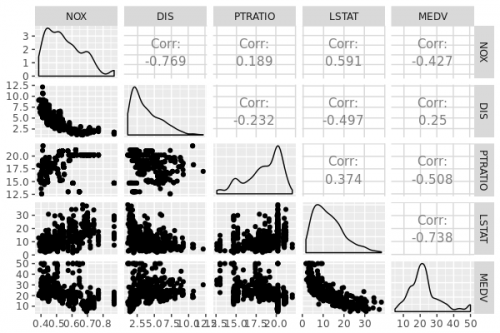
Sourcing Python scripts
source_python() にファイル名を指定することで Python のソースコードを R から呼ぶことができます。
今回は例として、以下の2つのデータセットに対し可視化・次元削減手法 UMAP と t-SNE の実行を Python で行い、埋め込み結果を R でプロットしてみます。
- MNIST: 0-9 の手書き数字画像に対応するラベルが関連付けられたデータセット
- Fashion MNIST: ファッション画像に対応する10クラスからのラベルが関連付けられたデータセット
UMAP は t-SNE と同程度の可視化の質 (visualization quality) を持ちつつも、高速でスケーラブルな可視化・次元削減手法です。UMAP のアルゴリズムの詳細については arXiv に投稿されている論文を参照ください。
R から呼ぶ Python コードは以下です。
import sys
sys.path.append("./fashion-mnist/utils")
import time
import mnist_reader
import umap
import numpy as np
from sklearn import datasets
from sklearn.manifold import TSNE
def load_mnist():
digits = datasets.fetch_mldata('MNIST original')
return digits.data/255.0, digits.target
def load_fmnist(path):
train_X, train_y = mnist_reader.load_mnist(path, kind='train')
test_X, test_y = mnist_reader.load_mnist(path, kind='t10k')
X = np.concatenate((train_X, test_X), axis=0)
y = np.concatenate((train_y, test_y), axis=0)
return X, y
def timeit(X, func, **kwargs):
start = time.time()
embedding = func(**kwargs).fit_transform(X)
end = time.time()
return embedding, end-start
def embed(dataset, method, path=""):
if dataset == "mnist":
X, y = load_mnist()
elif dataset == "fmnist":
X, y = load_fmnist(path)
else:
return "Unknown dataset"
if method == "tsne":
embedding, diff = timeit(X, TSNE, n_components=2)
elif method == "umap":
embedding, diff = timeit(X, umap.UMAP)
else:
return "Unknown embedding method"
return {"embedding": embedding, "labels": y, "time": diff}
embed() の戻り値は Dict 型で R に渡されるときに Named list に変換されます。
R のコードは以下です。 source_python() で上記の Python コードを読み込んだ後は、Python の関数を通常の R 関数のように呼ぶことができます。
library(tibble)
library(dplyr)
library(ggplot2)
library(reticulate)
use_condaenv("/home/t2sy/anaconda2/bin")
source_python("embedding.py")
plot_point <- function(df, color, title, label_name) {
ggplot(df, aes(x = V1, y = V2, colour = color)) +
geom_point(size = 0.75) +
labs(title = title, x = "", y = "") +
scale_colour_discrete(name = label_name)
}
# MNIST Digits Embedded via UMAP
res <- embed("mnist", "umap")
print(res$time)
g <- plot_point(as_tibble(res$embedding),
color = as.factor(res$labels),
title = "MNIST Digits Embedded via UMAP",
label_name = "Digits")
plot(g)
# MNIST Digits Embedded via t-SNE
res2 <- embed("mnist", "tsne")
print(res2$time)
g2 <- plot_point(as_tibble(res2$embedding),
color = as.factor(res2$labels),
title = "MNIST Digits Embedded via t-SNE",
label_name = "Digits")
plot(g2)
# Fashion MNIST Embedded via UMAP
fmnist_desc <- data.frame(label = c(0:9),
description = as.factor(c("T-shirt/top", "Trouser", "Pullover",
"Dress", "Coat", "Sandal", "Shirt",
"Sneaker", "Bag", "Ankle boot")))
res3 <- embed("fmnist", "umap", "./fashion-mnist/data/fashion")
print(res3$time)
fmnist_label <- data.frame(label = res3$labels) %>%
left_join(fmnist_desc, by = "label")
g3 <- plot_point(as_tibble(res3$embedding),
color = fmnist_label$description,
title = "Fashion MNIST Embedded via UMAP",
label_name = "Label")
plot(g3)
# Fashion MNIST Embedded via t-SNE
res4 <- embed("fmnist", "tsne", "./fashion-mnist/data/fashion")
print(res4$time)
g4 <- plot_point(as_tibble(res4$embedding),
color = fmnist_label$description,
title = "Fashion MNIST Embedded via t-SNE",
label_name = "Label")
plot(g4)
MNIST を UMAP と t-SNE で2次元に埋め込んだ結果は以下となりました。
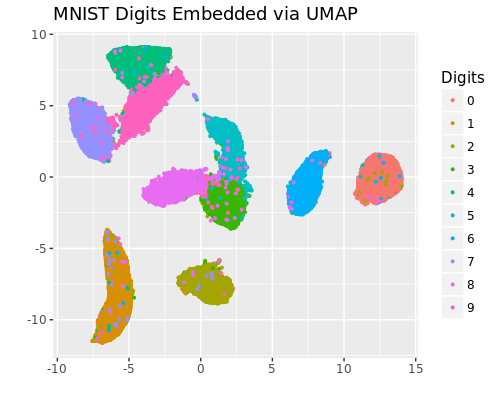
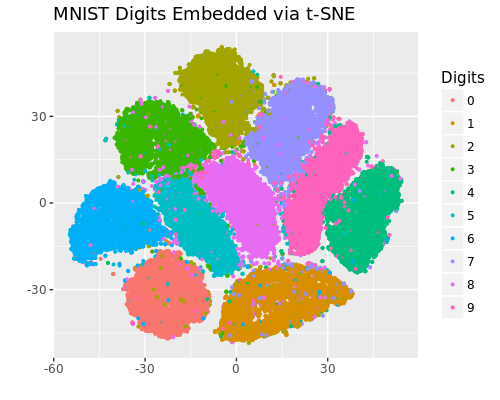
どちらの結果も概ね綺麗に10個のクラスタに分かれており、構造を保持したまま2次元に埋め込まれています。
Fashion MNIST を UMAP と t-SNE で2次元に埋め込んだ結果は以下となりました。
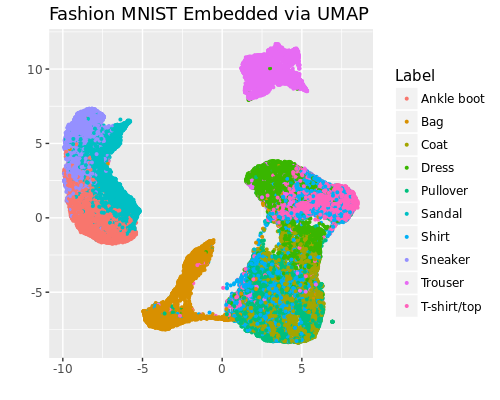
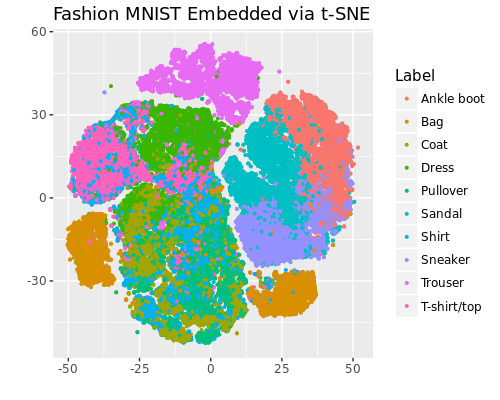
どちらの結果も Sandal, Ankle boot, Sneaker といった履物や Trouser、 Bag が独立したクラスタを形成しています。さらに、UMAPは大域的な構造も保持していることが窺えます。
続いて、実行時間 (3回の平均値) を確認してみます。t-SNE は scikit-learn 実装を使用しており、 t-SNE の論文著者による C++ を用いた高速な実装 bhtsne との比較ではない点にご注意下さい。
| DataSet | DataSet Size | UMAP | t-SNE (scikit-learn) |
|---|---|---|---|
| MNIST | 70,000 x 784 | 145.18 s | 9000.90 s |
| Fashion MNIST | 70,000 x 784 | 155.24 s | 9240.58 s |
MNIST、 Fashion MNIST に対して UMAP は t-SNE (scikit-learn) に比べ 60 倍程度高速であることがわかります。
おわりに
この記事では reticulate パッケージをご紹介しました。冒頭にも触れたように reticulate パッケージを使うことで R からシームレスに Python を呼ぶことができ、ワークフローの効率化が期待できます。
余談になりますが、私が reticulate パッケージを使おうと思ったきっかけは scikit-learn の API が統一的で使いやすいと感じる一方で Python の可視化ライブラリ Matplotlib や Seaborn などに慣れていないため、 R の ggplot2 でプロットしたいということでした。
▽NHN テコラスではいまからはじめるデータ活用・分析相談会を行っております。データ分析に関する技術的なお悩みにも個別にお答えしています。参加は無料なので、お気軽にお申し込みください。
参考文献
テックブログ新着情報のほか、AWSやGoogle Cloudに関するお役立ち情報を配信中!
Follow @twitter2016年11月、データサイエンティストとして中途入社。時系列分析や異常検知、情報推薦に特に興味があります。クロスバイク、映画鑑賞、猫が好き。
Recommends
こちらもおすすめ
-

Pythonで時系列データをクラスタリングする方法
2017.12.12
-

ディープラーニングを使ったウェブアプリケーションをすばやく作る
2018.12.1
-

BERTの学習済みモデルを使ってみる
2018.11.9
-

機械学習を学ぶための準備 その2(級数と積分について)
2015.12.2
Special Topics
注目記事はこちら

データ分析入門
これから始めるBigQuery基礎知識
2024.02.28

AWSの料金が 10 %割引になる!
『AWSの請求代行リセールサービス』
2024.07.16



